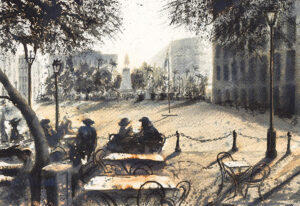MOHA Research Center presented the solo painting exhibition by Andreas Georgiadis entitled “The Alexandria Quartet”, based on the novel by Lawrence Durrell and curated by Fani-Maria Tsigakou, at the house of Mohammed Ali, Kavala.
The exhibition was presented for first time in Bibliotheca Alexandrina, October 2014, and was part of the celebrations to mark the 12th anniversary of the Opening of the Library. The artist received the major distinction of the “Key of City”, by Alexandria Governor. After Alexandria, the exhibition presented in Cairo, in the mamlook Palace AMIR TAZ, under the auspices of Egyptian Ministry of Culture. Third station was Greece, in IANOS ART GALLERY, under the auspices of British and Egyptian Embassies and fourth station was Hellenic Centre, London. The exhibition was last presented at Charoupomylos, Rethymnon, June 2016, as part of the program of the 19th International Lawrence Durrell Conference which was organized by the International Lawrence Durrell Society, winning very good reviews.
Through the 26 works in this group, all ink on paper, Andreas Georgiadis creates a fragile poetic environment, dotted with multiple readings, full of interchanges between what is real and what is imaginary.
“There are only as many realities as you care to imagine”
Pursewarden
Andreas Georgiadis, engrossed by Alexandria’s unique atmosphere and by the outstanding novel by the British author, creates a visual arts account of moments, impressions and reminiscences, combining the real with the imaginary, the past with the presence, the literal with the metaphorical.
After methodically researching a wealth of archival material, the artist recreates the 1940s era through his art, lingering on city landmarks that the author describes in the Quartet: theatres, cafés, beaches, restaurants, streets, squares, hotels, barber shops, houses, ports, railway stations, as well as snapshots of the leading figures in the novels. The Cecil Hotel, the Delices pastry shop, the Pastroudis café, Baudrot, the railway station, the western port, Rue Fouad, Rue des Soeurs, the Greek quarter, the Mohammed Ali Square, Police headquarters, the Al Attarine mosque, the vila Ambron -the house where Durrell lived in Alexandria-, the Arab quarter and, of course, the immense Corniche, all feature in the works in the exhibition, witnesses to the history of Alexandria during World War II, while simultaneously constituting a subjective people-based geography.
In the introductory text, Andreas Georgiadis mentions:
“I first read the Alexandria Quartet when I was twenty years old. I can still remember very vividly the riveting emotion of feeling that the world is (or may be) different. Lawrence Durrell’s reading of the world and of human relations engraved within me an altered anthropogeography. Twenty-two years old. I visit the city for the very first time. The reality was a revelation. Everyone and everything was there, untouched: Durrell, Cavafy, Tsirkas, Forster – the heroes of the Quartet. People, buildings, sounds, tastes, scents burnt by the desert and refreshed by the Mediterranean. And time has since rolled on. I frequently return to the Quartet to reread it. Slowly my dream-like contact with all that, which moves me most, gains a fluid dimension, as the ink sinks into my papers, recording semitones of light, feelings of loss or expectations, glances. I record more and more. These records take on features of a stable emotion. And when I am forty I am finally able to articulate what I want: a whole chapter of work dedicated to this book that has marked my life. I increase my real contact with the city, returning frequently, ceaselessly investigating roads and squares, buildings lost in time, cafés and restaurants. I attempt to prove to myself the reality of a reality. And, thankfully, everyone and everything still remains: The great Corniche, burns under the afternoon sun. Darley and Melissa walk, their arms around each other. Balthazar sits at Pastroudis café, and prepares his evening talk on Paracelsus and the gnostics. At the Cecil Hotel, Nessim asks Justine to marry him. Exactly opposite, on the fourth floor of the Metropole Hotel (Ministry of Public Works), C.P. Cavafy sits at his desk, hidden behind piles of books, assiduously correcting the latest proofs of a broadsheet poem sent over by the print works of Kassimatis & Ionas. In the evening he will meet E.M. Forster at the Mohammed Ali Club on Rue Fuad. For the time being, the latter is yet again taking the same tram, secretly hoping that Mohammed el-Adl will be the ticket inspector. Because this is the magic of Alexandria, with its “five races and five languages”. The real filters through the imaginary and vice versa, and has done for thousands of years now. Just beneath the exhausted skin of the excruciating present, one immediately feels the veins of yesteryear flowing unceasingly, simultaneously activating the act of memory. My own memory is in my drawing. I therefore return with this a gift in recompense: twenty-two years after the first reading, twenty after the first voyage: To Paraskevas Karasoulos, who taught me the Quartet, to Lawrence Durrell who was such a fascinating guide, to the city that inspired me from the very first instant.”
ABOUT THE ARTIST
Andreas Georgiadis was born in Thessaloniki in 1972. He lives and works at Imittos. He has had ten solo exhibitions in Greece and abroad (Athens, London, Cairo, Alexandria and so forth), and granted major distinctions. He has also participated in many group exhibitions. His work may be located in public and private collections. He contributed illustrations for numbers of books and records. He belongs to the artistic group of Mikri Arktos.













